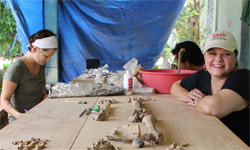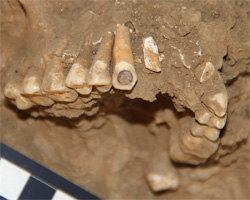Bio-Archaeological Dig Exposes Ancient Culture
SDSU Anthropology Professor Arion Mayes spent the summer excavating primitive burial grounds in Oaxaca, Mexico.

Leave it to an anthropologist to have a closet full of skeletons — literally. Arion Mayes does, and she can tell you the story behind each and every one of them.

“I work with human remains ranging from six months to 18,000 years old,” said the San Diego State University professor of anthropology.
Mayes, a bio-archaeologist who studies individual and population health by examining skeletal remains, just returned from the Lower Río Verde Valley of Oaxaca, Mexico. Along with student researchers from both sides of the border, she conducted burial excavations and analysis of the region’s ancient population at sites dating as far back as 400 B.C. The team generated important new data on more than 23 human and several animal remains.
This is an important feat, as Mayes explains it is critical to understand the connection between culture and biological health.
“I use biology, anatomy and physiology to interpret differences and similarities between people from one culture and environment to another. I then make connections about their human physical characteristics, including disease, daily activities and trauma, with the information we know about their culture,” Mayes said.

As director of bio-archaeology for the National Science Foundation-funded Río Viejo Polity Project in Oaxaca, Mayes is a part of a multi-institutional project that includes Art Joyce, University of Colorado, Boulder, the project lead, and Stacy Barber, University of Central Florida.
Connecting the digs
Mayes and her team researched human and animal remains from three archaeological sites in Oaxaca. One of the most dramatic findings — evidence of dental modification — aligned with findings at other sites in the region.
“In these very early groups, dental modification included inlays of exotic stones on the front teeth. In some cases, significant artifacts were also associated with these individuals such as burial vessels, obsidian blades and carved beads,” Mayes said.
“Dental modification appears to be reflective of an individual’s high or significant status during the time of burial,” Mayes said.
This year, the team also found a rare animal discovery — what they presume to be a puma — that showed evidence of having been an offering, deliberately placed near the wall of a structure. They excavated, reconstructed and analyzed the large cat burial.
Culture and biology
The Lower Río Verde Valley has proven to be an ideal site for excavation, allowing Mayes and her team to address questions of political, social and ecological change in the ancient past.
“By studying populations like this one that were in transition from one lifeway to another, we can observe the direct relationship of cultural processes on biology, including changes in diet, occupational stresses, disease, trauma and population variation over time,” Mayes said.
“The study of the biological history of the Lower Río Verde Valley allows a unique opportunity to describe and understand cultural processes of a population that did not follow theoretical models of state formation, thereby revealing new details on population adaptation and biological flexibility.”
A unique student experience
Mayes has been working in Oaxaca since 2003. Now in her sixth year taking along SDSU students, she is proud to be able to give student researchers a unique opportunity for international fieldwork and the chance to take part in excavations.
Graduate student Sydney Garcia is studying biological anthropology. A veteran, Garcia was inspired to go into the field after hearing about unidentified fallen service members. Her time in Oaxaca has helped her gain firsthand experience analyzing remains.
“This trip was an overall success for me. I made amazing connections, grew to love bio-archaeology and confirmed that forensic anthropology is what I am meant to do,” Garcia said.
For anthropology graduate student, Carlos Vega, who is originally from Mexico, the trip was both professionally and personally enriching.
“This is the first time I have been back to Mexico since leaving 11 years ago,” Vega said. “It was inspiring to dig and analyze ancient Mexican remains and special to be able to share those experiences with family I had not seen in a very long time.”



